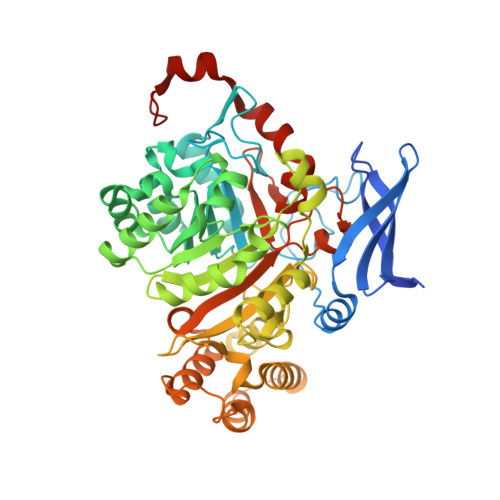Discovery, structure and mechanism of a tetraether lipid synthase.
Lloyd, C.T., Iwig, D.F., Wang, B., Cossu, M., Metcalf, W.W., Boal, A.K., Booker, S.J.(2022) Nature 609: 197-203
- PubMed: 35882349
- DOI: https://doi.org/10.1038/s41586-022-05120-2
- Primary Citation of Related Structures:
7TOL, 7TOM - PubMed Abstract:
Archaea synthesize isoprenoid-based ether-linked membrane lipids, which enable them to withstand extreme environmental conditions, such as high temperatures, high salinity, and low or high pH values 1-5 . In some archaea, such as Methanocaldococcus jannaschii, these lipids are further modified by forming carbon-carbon bonds between the termini of two lipid tails within one glycerophospholipid to generate the macrocyclic archaeol or forming two carbon-carbon bonds between the termini of two lipid tails from two glycerophospholipids to generate the macrocycle glycerol dibiphytanyl glycerol tetraether (GDGT) 1,2 . GDGT contains two 40-carbon lipid chains (biphytanyl chains) that span both leaflets of the membrane, providing enhanced stability to extreme conditions. How these specialized lipids are formed has puzzled scientists for decades. The reaction necessitates the coupling of two completely inert sp 3 -hybridized carbon centres, which, to our knowledge, has not been observed in nature. Here we show that the gene product of mj0619 from M. jannaschii, which encodes a radical S-adenosylmethionine enzyme, is responsible for biphytanyl chain formation during synthesis of both the macrocyclic archaeol and GDGT membrane lipids 6 . Structures of the enzyme show the presence of four metallocofactors: three [Fe 4 S 4 ] clusters and one mononuclear rubredoxin-like iron ion. In vitro mechanistic studies show that Csp 3 -Csp 3 bond formation takes place on fully saturated archaeal lipid substrates and involves an intermediate bond between the substrate carbon and a sulfur of one of the [Fe 4 S 4 ] clusters. Our results not only establish the biosynthetic route for tetraether formation but also improve the use of GDGT in GDGT-based paleoclimatology indices 7-10 .
- Department of Biochemistry and Molecular Biology, Pennsylvania State University, University Park, PA, USA.
Organizational Affiliation:






















